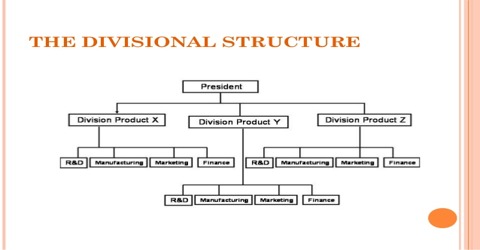Divisional Structure
The divisional structure is a type of organizational structure that groups each organizational function into a division. It is a type of organizational structure that groups each organizational function into a division. Many large organizations with diversified activities have reorganized themselves away from the simpler and basic functional structure towards a divisional structure which is more suited to their activities. Here, separate functions such as Production, HR, and finance can be seen under each division to support each product line. These divisions can correspond to either products or geographies.
In a divisional structure, the organization structure comprises of separate business units or divisions. Each unit has a divisional manager responsible for the performance and who has authority over the unit. It is helpful because the collapse of one division doesn’t directly pressure the other divisions. In the multidivisional structure, the subsidiaries advantage from the use of the brand and capital of the parent company. Generally, manpower is grouped on the basis of different products manufactured. Disadvantages can include prepared inefficiencies from extrication particular function. For the multidivisional structure, disadvantages can include increased accounting and taxes. Each division is multifunctional because within each division functions like production, marketing, finance, purchase, etc, are performed together to achieve a common goal.

Advantages: The divisional structure offers many benefits. It can be useful because it affords the company greater operational flexibility. Prominent among these are as follows:
- Product specialization helps in the development of varied skills in a divisional head and this prepares him for higher positions. This approach makes it much easier to assign responsibility for actions and results.
- Divisional heads are accountable for profits, as revenues and costs related to different departments can be easily identified and assigned to them. In particular, a division is run by its own management group, which looks out for the best interests of the division.
- It promotes flexibility and initiative because each division functions as an autonomous unit which leads to faster decision making. allows decision-making to be shifted downward in the organization, which may progress the company’s capability to respond to local market conditions.
- It facilitates expansion and growth as new divisions can be added without interrupting the existing operations by merely adding another divisional head and staff for the new product line. This approach tends to yield faster responses to local market conditions.
Disadvantages: The divisional structure has certain disadvantages. Common disadvantages of this structure include operational inefficiencies from separating specialized functions – for example, finance personnel in one division do not correspond with those in another division. Some of them are as follows:
- Conflict may arise among different divisions with reference to allocation of funds and further a particular division may seek to maximize its profits at the cost of other divisions. It is also more difficult to cross-sell products and services between the divisions.
- It may lead to an increase in costs since there may be a duplication of activities across products. When you set up a total set of functions within each division, there are likely to be more employees as a whole than would be the case if the business had as a substitute been organized under a purely functional structure.
- It provides managers with the authority to supervise all activities related to a particular division. When there are a number of functional areas increase among many divisions, no one purposeful area will be as efficient as would have been the case if there had instead been one central organization for each function.
- Each division will tend to have its own strategic direction, which may differ from the strategic direction of the company as a whole.
















